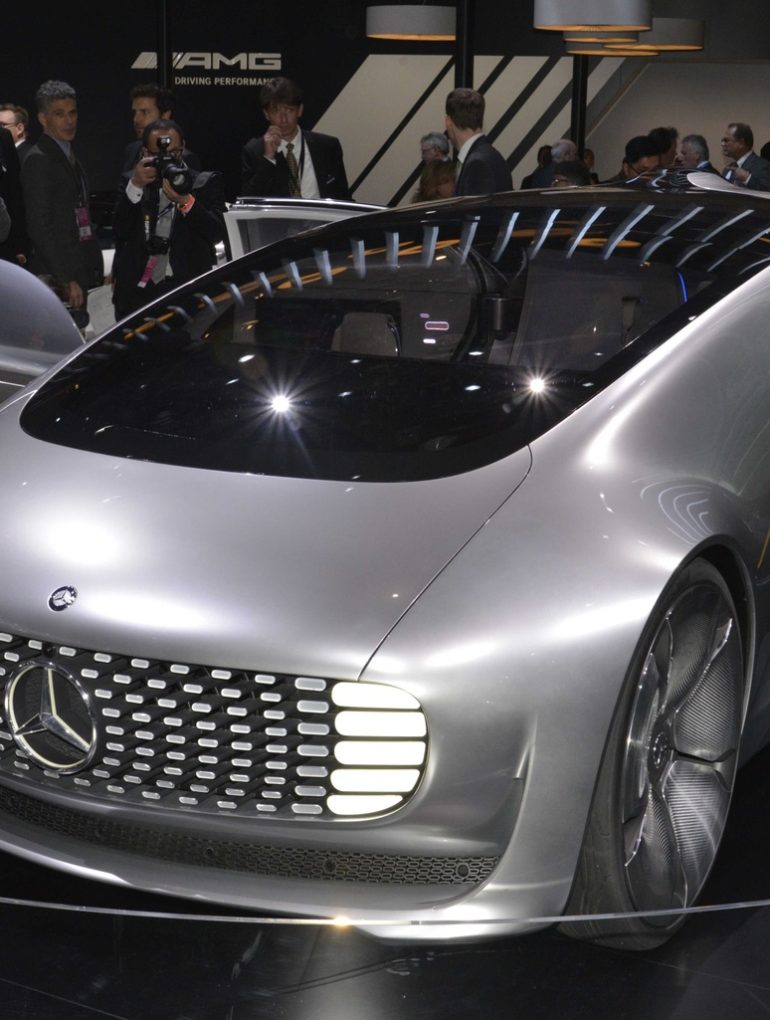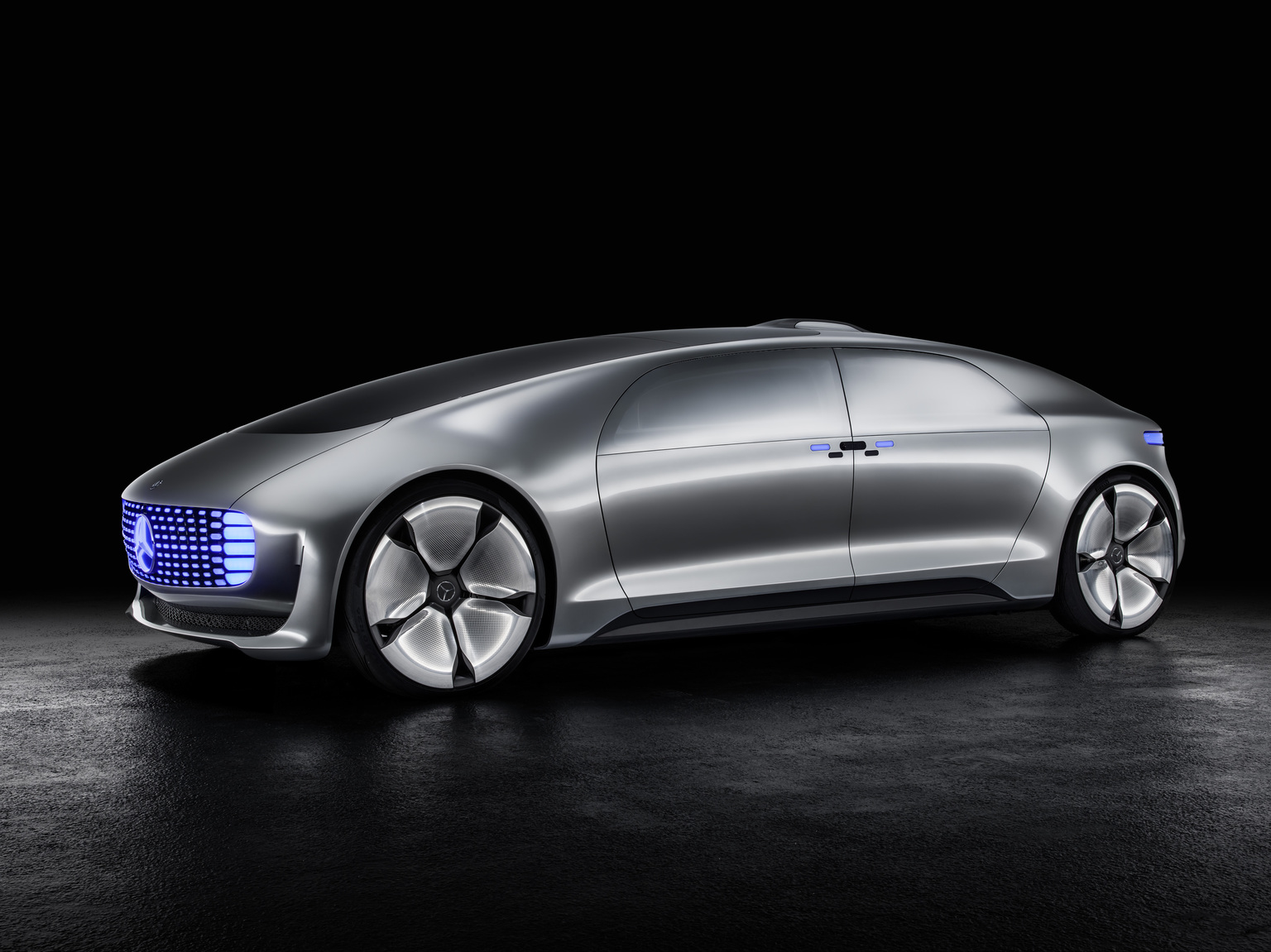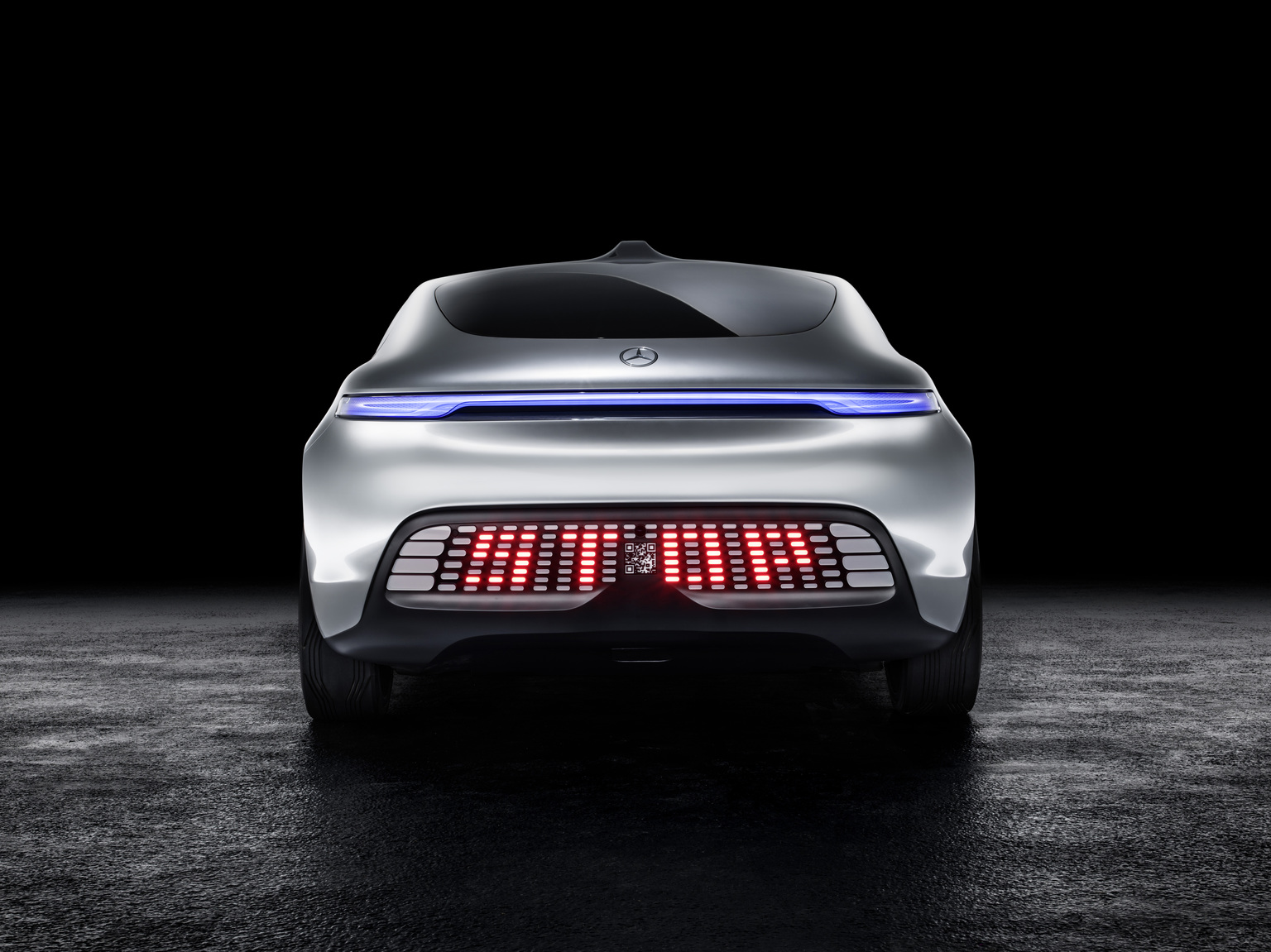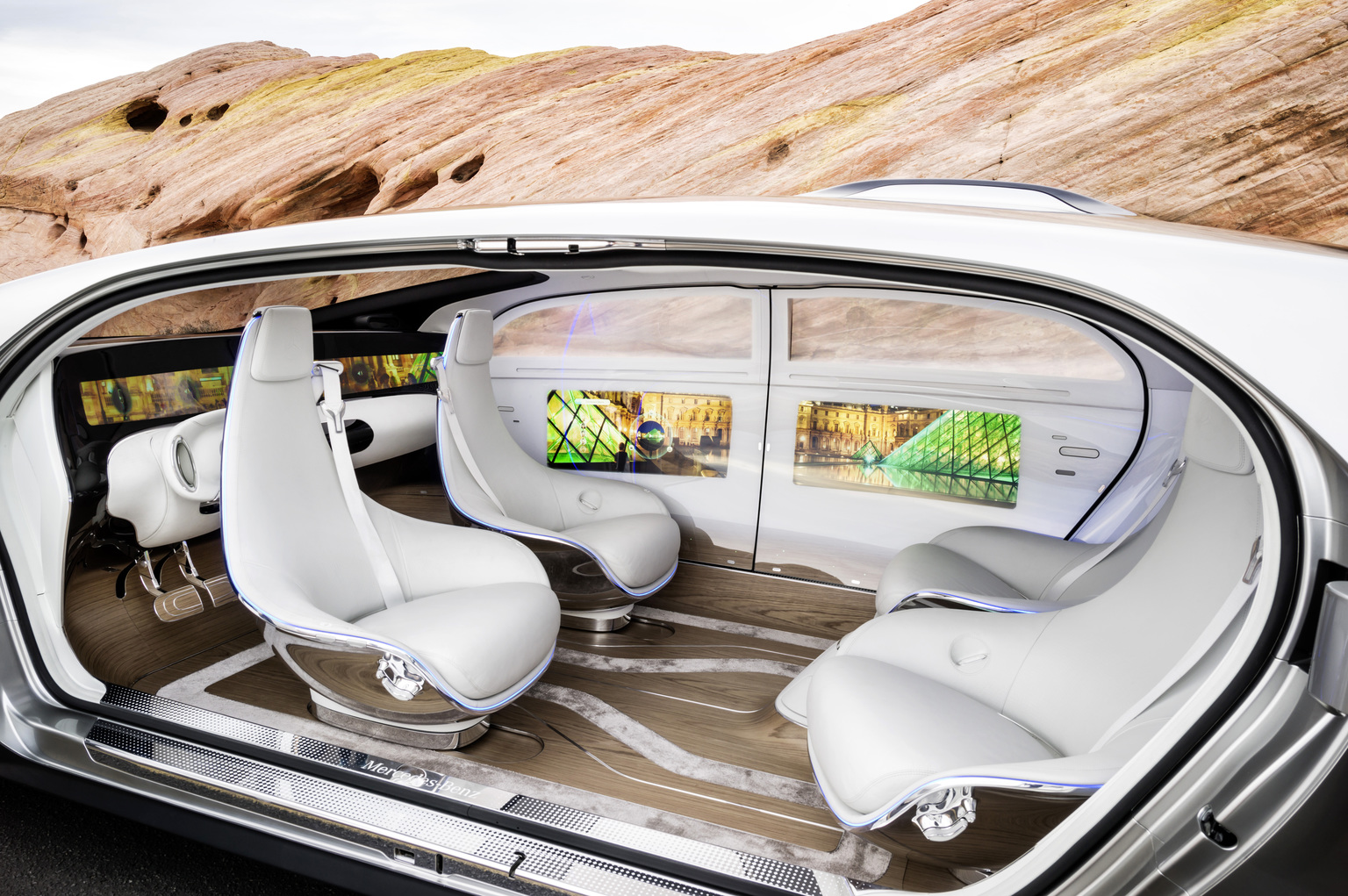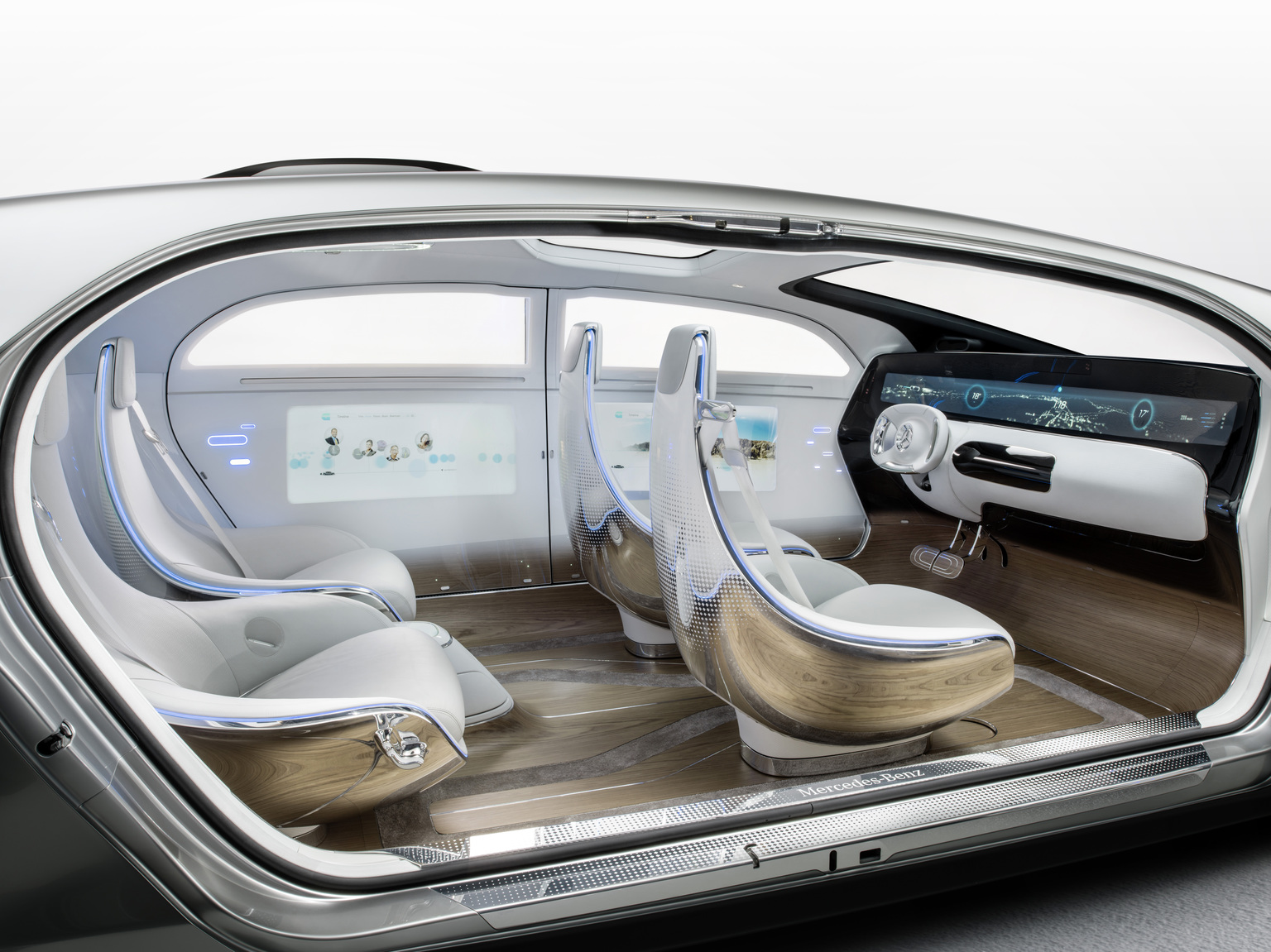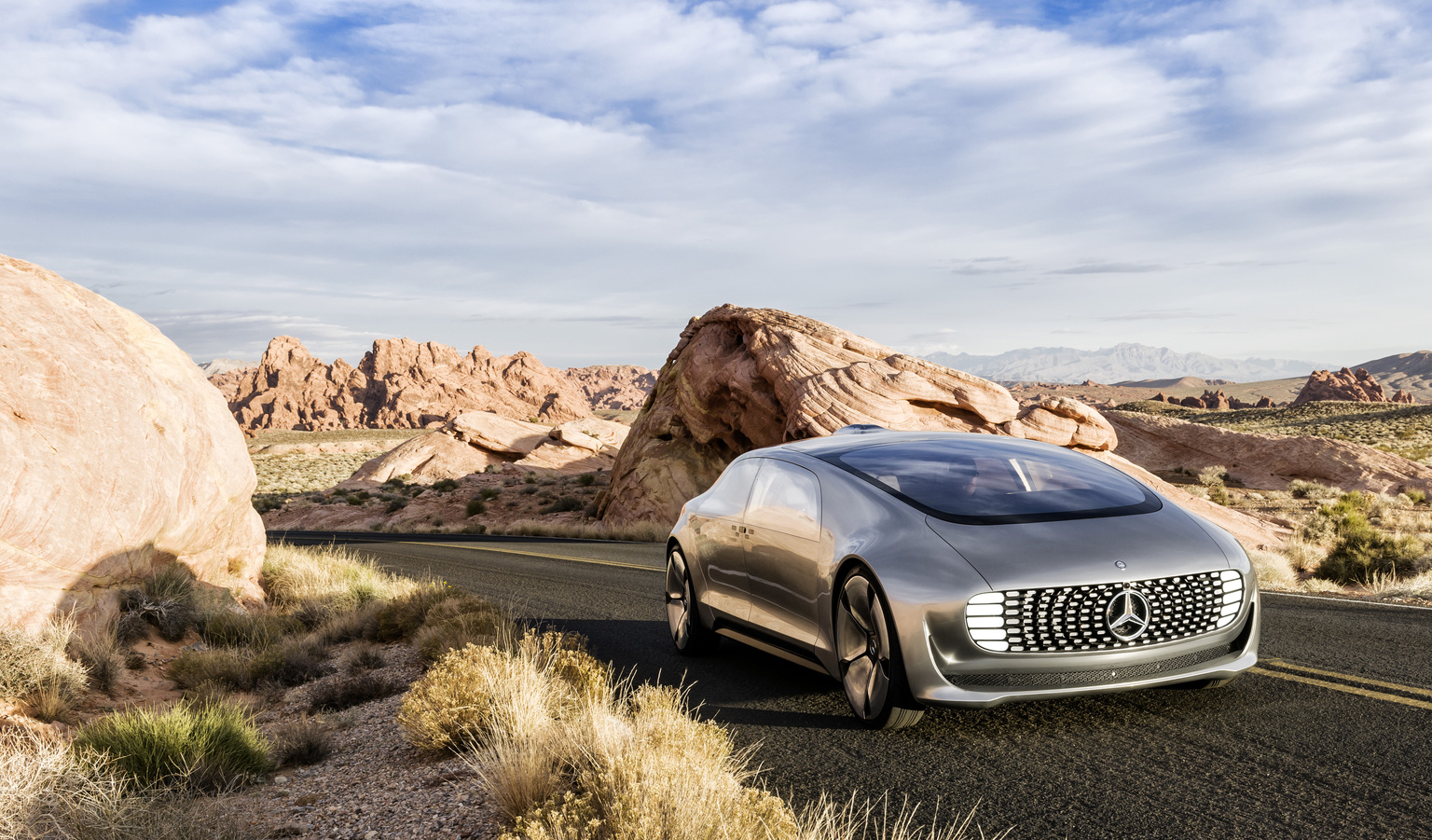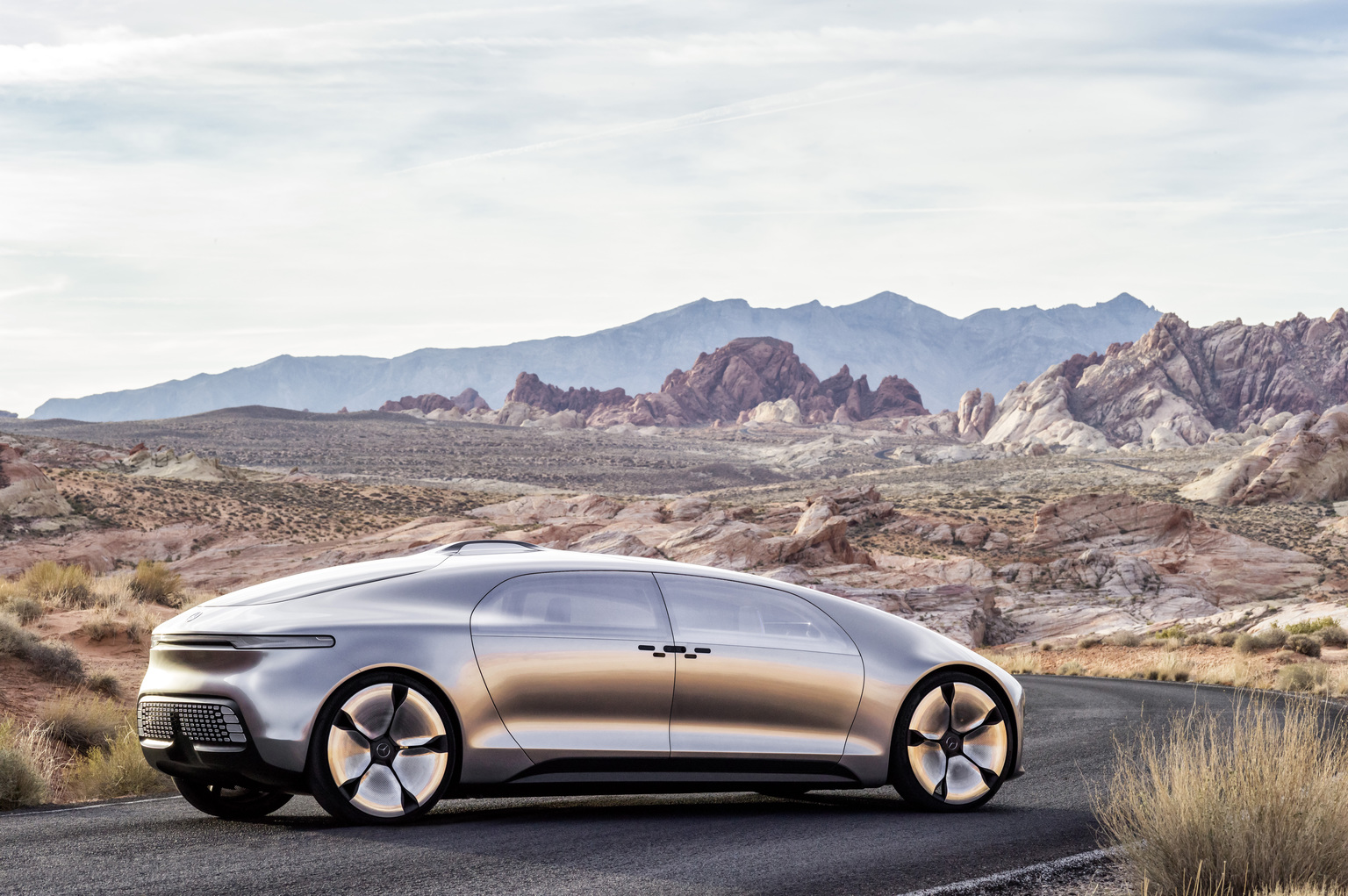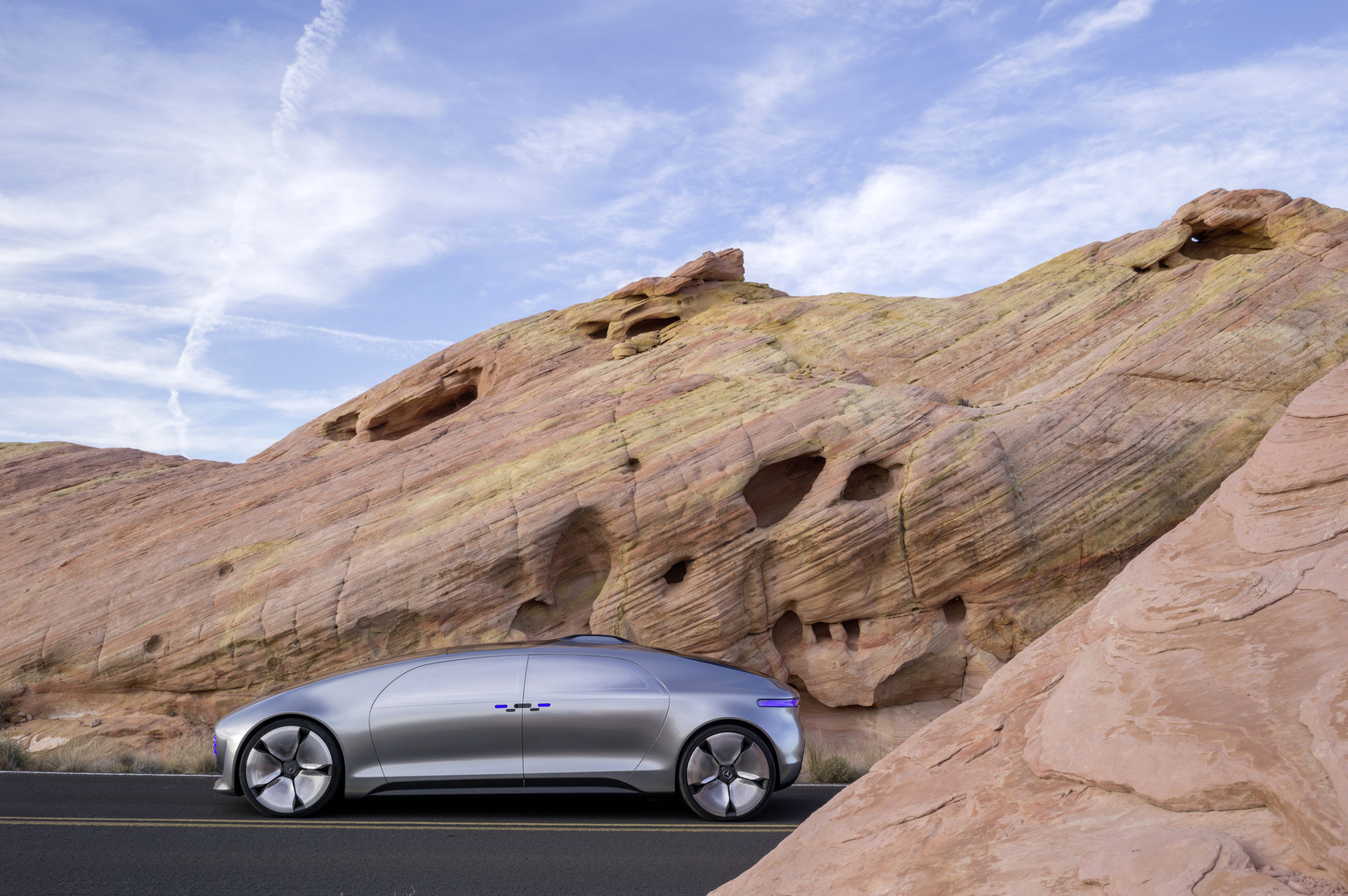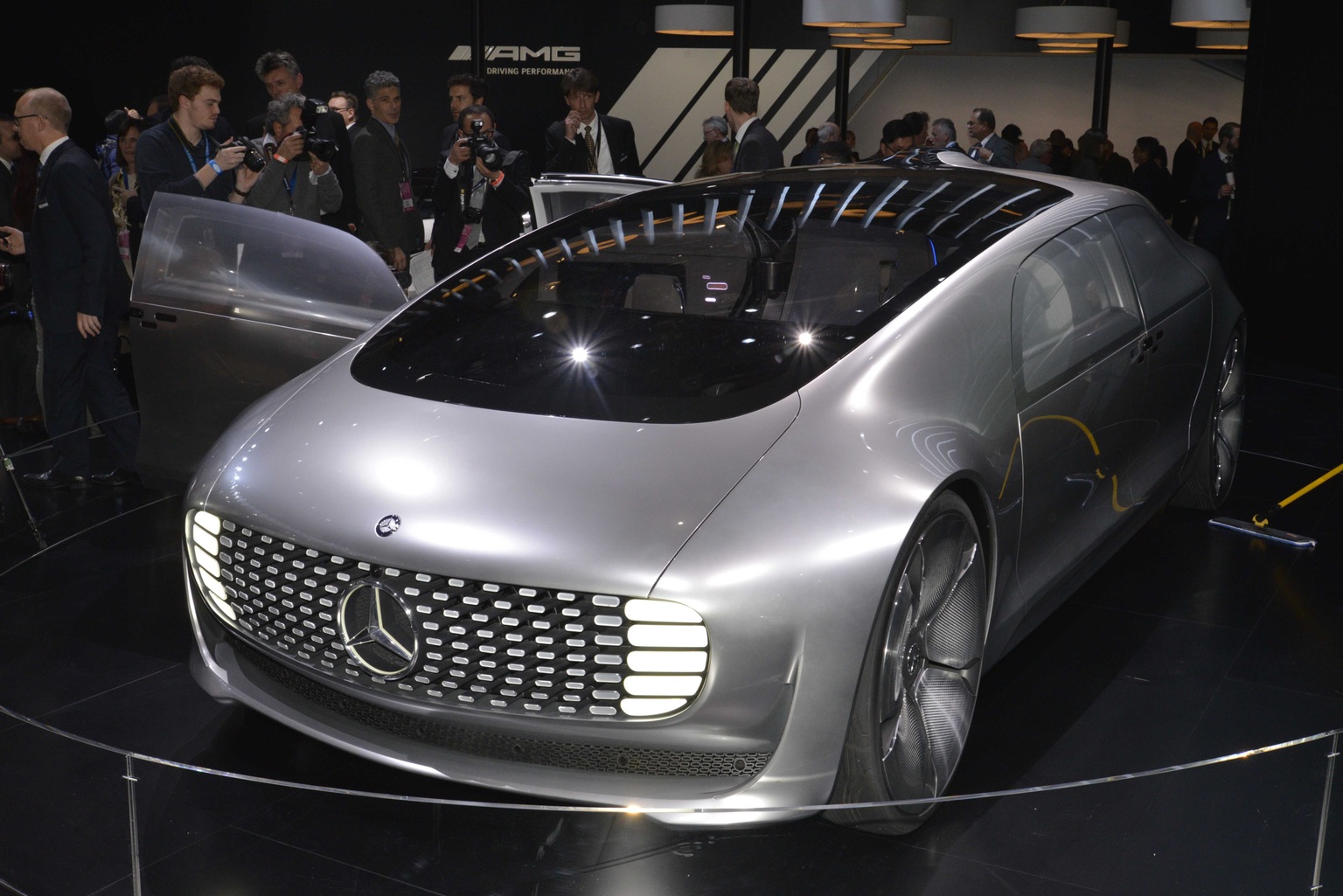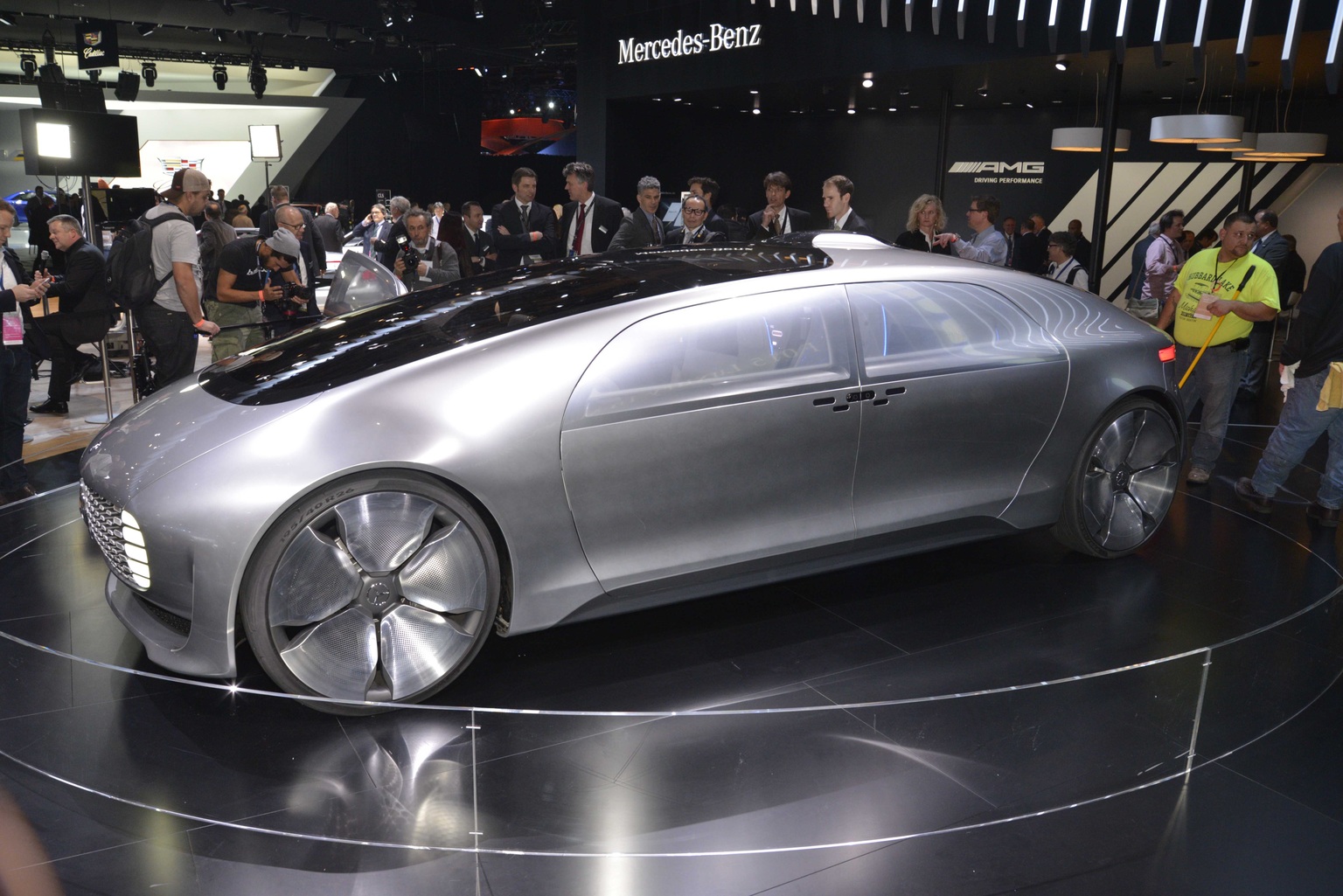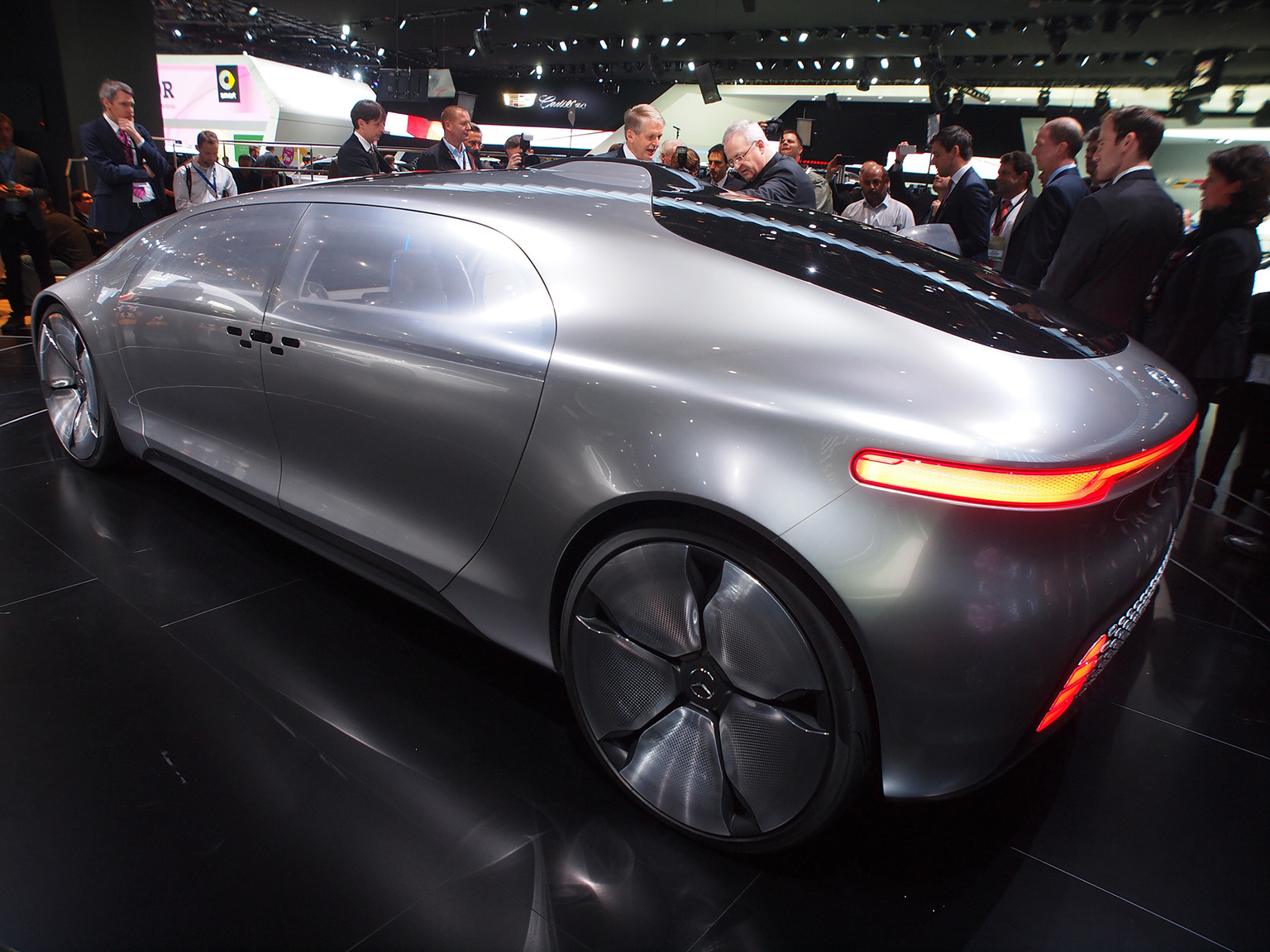2015 Mercedes-Benz F 015 Luxury in Motion
With the S 500 INTELLIGENT DRIVE and the Future Truck 2025, Mercedes-Benz has already made the vision of autonomous driving reality. The new research vehicle F 015 Luxury in Motion has its world premiere at the Consumer Electronics Show, and provides a concrete example of the visionary ideas the company is developing with regard to autonomous driving of the future. With this self-driving luxury sedan Mercedes-Benz illustrates how the car is growing beyond its role as a mere means of transport and will ultimately become a private retreating space. This new way of traveling gives passengers the freedom to use their valuable time on the road in manifold ways.
Progressing from the self-propelled (“automotive”) to the self-reliant (“autonomous”) vehicle, Mercedes-Benz as a pioneer goes far beyond the purely technical realization of automated driving. The company’s experts also have to anticipate different outlooks and social trends. People are always at the center of such considerations. Just as the 1886 Benz Patent Motor Car and its successors revolutionized personal mobility and, as a consequence, society as a whole, the first self-driving cars will also bring about major changes.
“Anyone who focuses solely on the technology has not yet grasped how autonomous driving will change our society. The car is growing beyond its role as a mere means of transport and will ultimately become a mobile living space,” explains Dr. Dieter Zetsche, Chairman of the Board of Management of Daimler AG and Head of Mercedes-Benz Cars.
Expressive forerunner of a mobility revolution
With the huge amount of space in its lounge-like interior, the Mercedes-Benz F 015 Luxury in Motion takes the concepts of comfort and luxury to a new level. Every facet of the vehicle reflects perfectly the Mercedes way of interpreting the terms “modern luxury”, emotion and intelligence. This innovative four-seater is a forerunner of a mobility revolution, and this is immediately apparent from its futuristic appearance.
It is obvious that the F 015 represents the vision of a brand new vehicle concept just from its unusual proportions (length/width/height: 5220/2018/1524 millimeters), its seamless, monolithic exterior and its large LED light modules at the front and rear. A range of different lighting functions can be provided through these LED fields. At the same time, the vehicle communicates and interacts with the outside world by means of the LED fields. These LED fields show for example, if the F 015 is driving autonomously (blue) or is controlled manually (white).
The low-slung front end, smooth and streamlined roof line, flat front windshield and road-hugging rear end give the F 015 Luxury in Motion an extended and decidedly dynamic silhouette. The F 015 Luxury in Motion’s unusually large wheelbase of 3610 millimeters in combination with its short overhangs clearly show that the design focus was on providing the maximum possible space for the passengers.
A lounge-like interior with an atmosphere of wellbeing
In the interior of the F 015 Luxury in Motion the designers have created a lounge-like space with a feel-good ambience characterized by elegance, quality and lightness. Sensual, flowing transitions and warm, organic materials such as open-pore walnut wood shaped into a three-dimensional veneer, and extremely soft ice white nappa leather contrast with clearly-defined metal and glass surfaces with a cool and technical feel.
The pivotal feature of the innovative interior concept is the variable seating system, with four rotating lounge chairs that allow a face-to-face seat configuration. In order to make getting in and out of the car easier, the electrically powered seats also swing outwards by 30 degrees as soon as the doors are opened. If necessary, the driver and front-seat passenger can also turn their eyes and attention towards the front ��� a prerequisite for manual driving. To this end the steering wheel extends automatically from the dashboard.
The leather-covered cushions of the lounge chairs are set in curved mounts of highly-polished aluminium. Each seating mount has a contrasting light band of blue LED lights and can also be manually swiveled.
One key aspect of the research vehicle is the continuous exchange of information between vehicle, passengers and the outside world. This is facilitated by six display screens harmoniously integrated into the instrument panel and the rear and side panels, which turn the interior of the F 015 Luxury in Motion into a digital arena. Passengers can interact intuitively with the connected vehicle through gestures, eye-tracking or by touching the high-resolution screens. Sensors recognize the passengers’ hands and offer them user interfaces within convenient reach that present appropriate operating options for each particular situation. Particle streams on the displays visualize the vehicle’s movement.
Revolutionary vehicle structure
The high-strength body of the F 015 Luxury in Motion ensures optimum safety and supreme comfort for its passengers. At the same time, the bodyshell’s structure provides the ideal basis for the door concept that makes getting in and out especially easy, and for the communication-oriented seating featuring four lounge chairs in a face-to-face arrangement.
New materials and structures were used to develop the highly efficient “Smart Body Structure (SBS)” of the F 015. By cleverly combining carbon-fiber-reinforced plastic (CFRP), aluminum and high-strength steels in a way that matches the varying requirements exactly, the lightweight engineering experts were able to make the bodyshell 40 percent lighter compared with today’s production vehicles.
Another key element of the body design concept is the innovative saloon-door-style door system featuring rear-hinged rear doors. The front and rear doors can be opened and closed independently of one another. With an opening angle of 90 degrees for all doors, the spacious interior can be easily and comfortably accessed on both sides. B-pillars were not needed. A very sturdy interconnected system with mechanical locking elements ensures exemplary safety standards. These elements securely interlock the front and rear doors when they are closed at the same time as fixing them firmly to the roof frame and side skirts. The resulting composite load path allows an extremely high amount of energy to be absorbed in the event of frontal or side impact, with minimal intrusion into the passenger compartment.
The doors themselves have a crucial role to play in the vehicle’s passive safety concept. The crash-responsive beltlines underneath the side windows are vital here. The PRE-SAFE Structure, previously unveiled on the ESF 2009 Experimental Safety Vehicle and now further enhanced, offers maximum safety while taking up minimum space: in a side-on collision, these bodywork elements “inflate” in an instant, just like an airbag, allowing them to absorb as much impact energy as possible.
In addition, the bodyshell of the F 015 Luxury in Motion was designed to allow the impact-protected integration of an electric drive system with fuel cell. This is based on the pioneering F-CELL PLUG-IN HYBRID system seen in the F 125! research vehicle from 2011, and combines on-board generation of electricity with an exceptionally powerful and compact high-voltage battery. The pressure tank made from CFRP is designed to store the hydrogen.
The vision: greater quality of life for all city dwellers
As a foundation for creating the F 015 Luxury in Motion, experts from all areas of Mercedes-Benz developed a future scenario entitled “City of the Future 2030+”, which considered many aspects of mobile living.
The greater the advance of urbanization, the greater is the desire of the individual to be able to retreat to a private sphere. Autonomous driving will become a given. As drivers are relieved of work and stress in situations in which driving is not enjoyable, the time gained while in their car takes on a whole new quality. Time and space will become the luxury of the future.
New technologies and forms of communication open up numerous new possibilities for interaction, both between the vehicle and its passengers and between the vehicle and other road users.
Autonomous cars also open up new possibilities for urban infrastructure design. Following the example of today’s low-emission zones in city centers, special “safety zones” that are only accessible to autonomous vehicles could be created. Urban space would be regained by autonomous vehicles parking themselves on the periphery.
In the shared space of the future, humans and machines share the roads. The “car-friendly city” is transformed increasingly into the “people-friendly city” without any loss of individual freedom. The divide between residential, recreational and traffic areas therefore melts away. The result is superior quality of life for all urban dwellers.
The road to autonomous driving
Even now, vehicles from Mercedes-Benz are capable of detecting many different hazardous situations out on the road and reacting as the situation demands ��� by means of autonomous braking, for instance. And from the C-Class through to the S-Class, there are already Mercedes-Benz models driving semi-autonomously on public roads today, equipped with features such as DISTRONIC PLUS with Steering Assist and the Stop&Go Pilot semi-autonomous traffic jam vehicle following function. Active Parking Assist with PARKTRONIC allows automated parking with active steering and brake control in both parallel and end-on spaces.
In August 2013, Mercedes-Benz demonstrated to great effect that autonomous driving is possible now, even in complex urban and rural traffic situations. The close-to-production Mercedes-Benz S 500 INTELLIGENT DRIVE completed the approximately 100-kilometer journey from Mannheim to Pforzheim fully autonomously, following the route Bertha Benz took in 1888 on the first ever long-distance drive by car.
Mercedes-Benz is setting the pace of development in the area of trucks, too ��� as the innovator and launcher of intelligent assistance systems. With its Future Truck 2025, the brand presented the world’s first truck to feature autonomous driving at the IAA Commercial Vehicles in September 2014. In July 2014, this one-off vehicle, based on the Mercedes-Benz Actros 1845, drove at speeds of up to 80 km/h in realistic traffic situations on a section of the A14 autobahn near Magdeburg.
As a global company, Mercedes-Benz has its sights set on autonomous driving worldwide. In order to factor in the differences in traffic and infrastructure in other markets, the experts also carry out testing in the USA, for example. In mid-September 2014, Mercedes-Benz became one of the first automotive manufacturers to be issued with an official license by the US state of California for testing self-driving vehicles on public roads there. In addition the company makes use of the USA’s largest test facility, the Concord Naval Weapons Station (CNWS).
Contacts:
Koert Groeneveld
tel.:
image: chrome-extension://lifbcibllhkdhoafpjfnlhfpfgnpldfl/call_skype_logo.png

[email protected]
Matthias Brock
tel.:
image: chrome-extension://lifbcibllhkdhoafpjfnlhfpfgnpldfl/call_skype_logo.png

[email protected]
Further information about Mercedes-Benz is available online: www.media.daimler.com and www.mercedes-benz.com
The Mercedes-Benz management team on the F 015 Luxury in Motion
“The car is becoming a mobile living space”
“Anyone who focuses solely on the technology has not yet grasped how autonomous driving will change our society. The car is growing beyond its role as a mere means of transport and will ultimately become a mobile living space.”
Dr. Dieter Zetsche, Chairman of the Board of Management of Daimler AG and Head of Mercedes-Benz Cars
“Autonomous driving is one of the greatest innovations since the invention of the motorcar. Drivers are relieved of work and stress in situations in which driving is not enjoyable, and the time gained while in their car takes on a whole new quality.”
Prof. Dr. Thomas Weber, Member of the Board of Management of Daimler AG, responsible for Group Research and Head of Mercedes-Benz Cars Development
“Visionary concepts as the F 015 are vital for fueling the social discourse on mobility and the design of urban habitats. An essential part of our culture of innovation is to make humans, with their needs and desires, the central focus of our considerations and developments.”
Prof. Dr. Herbert Kohler, Head of Corporate Research & Sustainability and Chief Environmental Officer for Daimler AG
“With the F 015 Luxury in Motion we wanted to design a luxurious vehicle with a lounge-like ambience in the interior, which combines sensuality with purity in a very special way and appeals equally to the intellect and to the emotions, thereby exerting a natural appeal. In addition, its exterior had to signal its visionary and pioneering character at first glance.”
Gorden Wagener, Vice President Design Daimler AG
“City of the Future 2030+” vision
Shared space in tomorrow’s world
F 015 Luxury in Motion in the city traffic of the future
Mercedes-Benz provides technically feasible and socially desirable solutions to the challenges of mobility
In order to provide a foundation for the new autonomous F 015 Luxury in Motion research vehicle, an interdisciplinary team of experts from Mercedes-Benz has devised a future scenario that incorporates many different aspects of day-to-day mobility. Above and beyond its mobility function, this scenario perceives the automobile as a private retreat that additionally offers an important added value for society at large.
“Anyone who focuses solely on the technology has not yet grasped how autonomous driving will change our society,” emphasises Dr Dieter Zetsche, Chairman of the Board of Management of Daimler AG and Head of Mercedes-Benz Cars. “The car is growing beyond its role as a mere means of transport and will ultimately become a mobile living space.”
In the same way the 1886 Benz Patent Motor Car and its successors revolutionized personal mobility and, as a consequence, society as a whole, the first self-driving cars will also bring about major changes. Visions are vital for fueling the social discourse on future mobility and the design of urban habitats, as is seeing things from an all-encompassing perspective.
Not just crystal ball gazing
The “City of the Future 2030+” vision: urbanization has continued to advance, and the little urban space there is today is scarcer than ever. In an urban environment where space is at a premium and everything happens at a hectic pace, people have a growing desire for privacy and a place to retreat to. Autonomous driving is taken for granted ��� it is accepted by society and the technology is perfectly reliable. As the autonomous car takes over from the driver in situations where driving isn’t much fun, such as slow-moving traffic, it gives real added quality to time spent out on the road. The passengers in self-driving cars use their newly gained free time while traveling for relaxing or working as they please.
New technologies and forms of communication open up a whole host of new possibilities for interaction, both between the vehicle and its passengers and between the vehicle and other road users. The relationship between human and car is configured in such a way that the autonomous car assumes those tasks the human does not wish to carry out or cannot carry out, such as maintaining a permanent 360-degree all-round view. The human, on the other hand, decides how fast the car should move or which route is more scenic. The result is a new form of ‘teamwork’ between vehicle and driver that will make people’s lives easier.
New scope for designing the urban infrastructure
Autonomous cars also open up new possibilities for urban infrastructure design. The streetscape is set to change. Following the example of today’s low-emission zones in city centers, special “safety zones” that are only accessible to autonomous vehicles could be created. The removal of surplus streets and road signs could furthermore free up valuable space in the densely populated megacities. Urban space would also be regained by autonomous vehicles parking themselves on the periphery. This alone could eliminate around a third of the city traffic produced today by vehicles searching for a parking spot.
Extensive connectivity and communication would allow traffic composed of autonomous vehicles to flow more smoothly and take up fewer lanes. Traffic would become more free-flowing again as a result of vehicles moving continuously. Overall, personal mobility would be more comfortable, more stress-free and safer.
Shared space in tomorrow’s world
In the shared space of the future, humans and machines share the roads. The “car-friendly city” is transformed increasingly into the “people-friendly city” without any loss of individual freedom and the possibility to use the car. Main access roads in the cities that were previously busy with traffic become attractive places for living, shopping and strolling again. The divide between residential, recreational and traffic areas therefore melts away. The result is superior quality of life for all urban dwellers. The technology will also offer older people and people with disabilities who are not able to drive themselves the opportunity to enjoy personal mobility. Beyond the high-density urban areas with ���safety zones���, there will be mixed traffic where self-driving vehicles use the roads together with conventionally driven cars. The extensive sensor systems and communication facilities will yield substantial benefits for all road users.
Mercedes-Benz experts engaged in a dialogue on the future of mobility
Mercedes-Benz regularly invites interested parties to take part in a dialogue on the future of mobility. For example, the Future Talk introduced by Mercedes-Benz in 2013 established a new dialogue format and asked the question “How utopian is the future?” In dialogue with the avant-garde in different disciplines, Mercedes-Benz experts shared their visions of shaping a desirable mobile future. The focus of the Mercedes-Benz Future Talk “Robotics” in July 2014 was the interaction between man and machine.
Interview with Thomas Weber and Herbert Kohler
“Autonomous driving is one of the greatest innovations since the invention of the automobile”
*Vision 2030+: autonomous driving becomes part of day-to-day mobility
*New driving culture allowing good use to be made of time spent in the car
*More than eye contact: trust between human and machine
Since the early 1970s, Mercedes-Benz has unveiled more than a dozen visionary research vehicles. Numerous technological features have already found their way into series production. With the new F 015 Luxury in Motion, Mercedes-Benz is once again underlining the pioneering role it plays in the development of visionary automotive concepts. The focus this time has been clearly placed on autonomous driving.
Progressing from the self-propelled
(“automotive”) to the self-reliant (“autonomous”) car takes Mercedes-Benz research and development far beyond the purely technical implementation of automated driving. The company’s experts also have to anticipate different outlooks and social trends. Humans, with their needs and desires, are always at the heart of their considerations, though.
Prof. Dr. Thomas Weber, Member of the Board of Management of Daimler AG responsible for Group Research and Mercedes-Benz Cars Development, and Prof. Dr. Herbert Kohler, Head of Group Research & Sustainability and Chief Environmental Officer for Daimler AG, explain the company’s vision of autonomous driving as well as further steps along the road to revolutionizing mobility.
For the first time, the F 015 Luxury in Motion explores the possibilities offered by autonomous driving in depth. What significance do you see the self-driving car as having?
Prof. Dr. Thomas Weber: Autonomous driving is one of the greatest innovations since the invention of the automobile. Drivers are relieved of work and stress in situations in which driving is not enjoyable, and the time gained while in their car takes on a whole new quality: the freedom to do other things while driving instead of steering, accelerating and braking.
In Detail
| submitted by | admin |
| type | Concept / Prototype Car |


